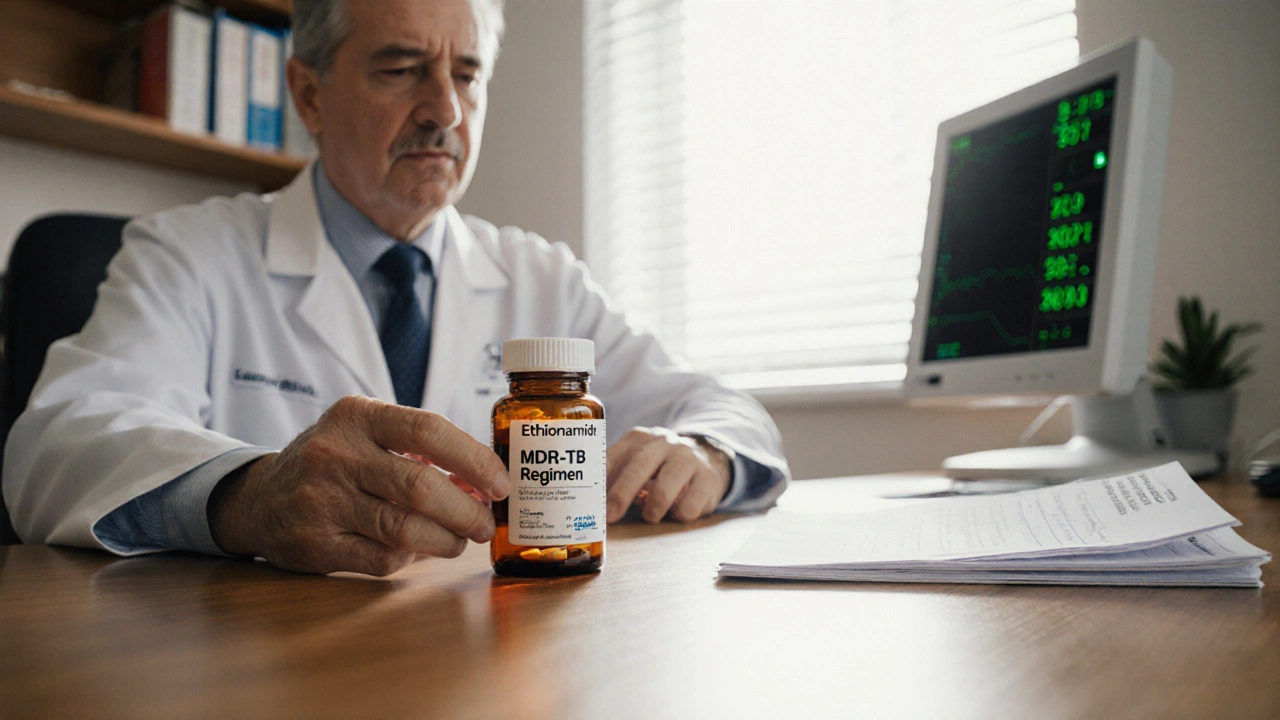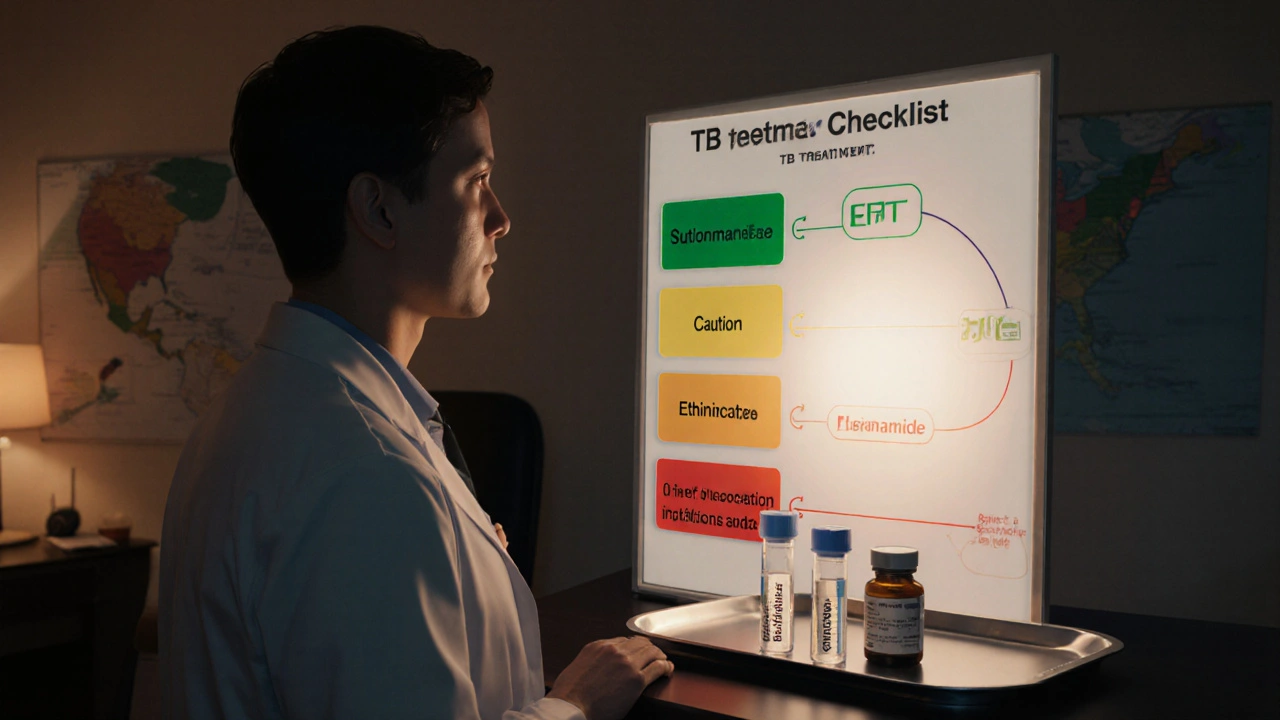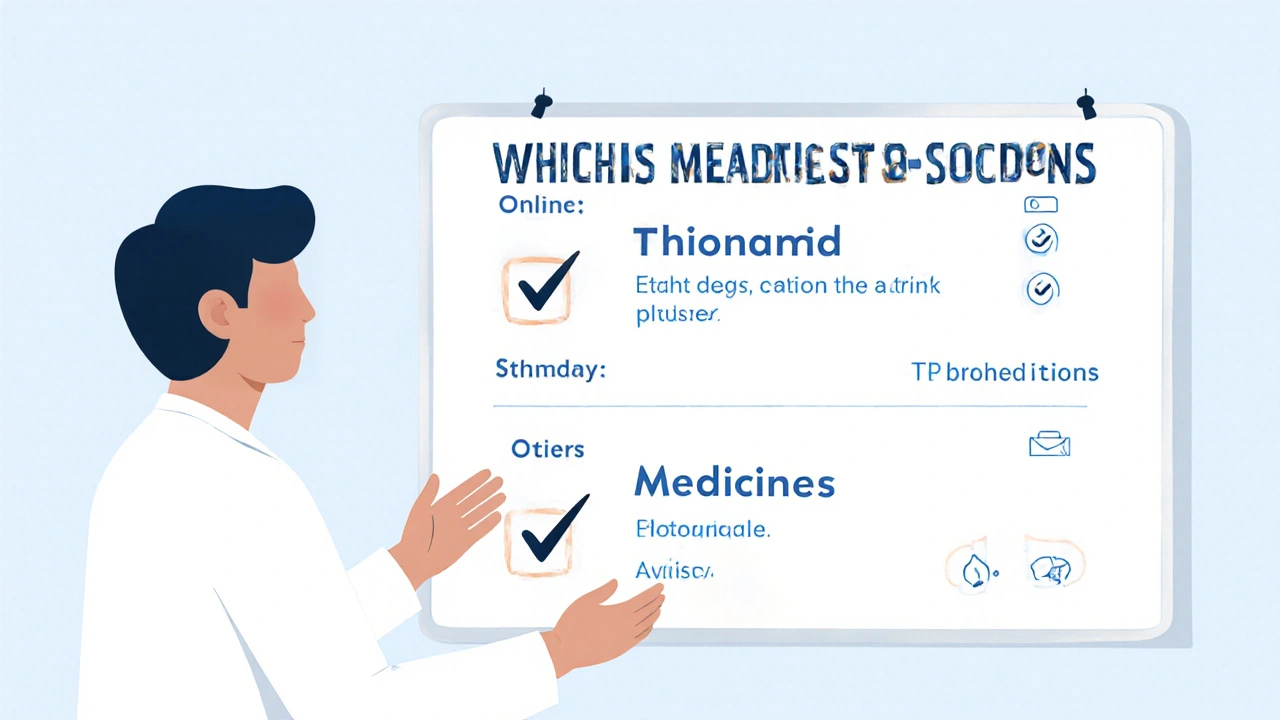
TB Drug Selection Tool
Select Your Clinical Scenario
Answer the following questions to determine appropriate TB medications for your patient.
When a doctor prescribes a second‑line drug for multidrug‑resistant tuberculosis (MDR‑TB), chances are you’ll hear the name Ethionamide. But how does it stack up against the other weapons in the TB arsenal? This guide walks you through the nitty‑gritty of Ethionamide, its main rivals, and when each might be the right pick.
Quick Summary
- Ethionamide is a second‑line oral TB drug, mainly for MDR‑TB.
- Key alternatives include Isoniazid, Rifampin, Ethambutol, Pyrazinamide, Streptomycin, Kanamycin and Levofloxacin.
- Side‑effects differ: Ethionamide often causes GI upset and hepatotoxicity, while others may trigger visual loss, ototoxicity, or tendonitis.
- Choose Ethionamide when resistance patterns rule out first‑line agents and the patient can tolerate its hepatic and GI profile.
- Use the decision checklist to match drug properties with your clinical scenario.
What is Ethionamide?
Ethionamide is a second‑line oral medication used to treat multidrug‑resistant tuberculosis (MDR‑TB). It belongs to the thioamide class and works by inhibiting the synthesis of mycolic acids, essential components of the bacterial cell wall. Typical adult dosing starts at 15‑20mg/kg per day, split into two doses, and can be continued for 18‑24months in MDR‑TB regimens.
Because Ethionamide is metabolized in the liver, doctors keep a close eye on liver enzymes. Common complaints include nausea, vomiting, loss of appetite, and a metallic taste. More serious but rarer issues involve hepatitis and peripheral neuropathy.
Key Alternatives to Ethionamide
Below are the most frequently considered drugs when you need to replace or supplement Ethionamide.
Isoniazid is a first‑line oral agent that blocks mycolic acid production. It’s usually given at 5mg/kg daily and forms the backbone of standard TB therapy.
Rifampin is a bactericidal antibiotic that inhibits RNA synthesis. Dosage typically sits at 10mg/kg daily, and it’s known for turning urine orange.
Ethambutol is a drug that blocks arabinosyl transferase, impairing cell wall assembly. Standard dosing is 15‑25mg/kg daily, but eye exams are mandatory due to risk of optic neuritis.
Pyrazinamide is an agent that works best in acidic environments, disrupting bacterial metabolism. Adults take 15‑30mg/kg daily for the intensive phase of treatment.
Streptomycin is an injectable aminoglycoside that interferes with protein synthesis. Typical dosing is 15mg/kg once daily, but hearing loss is a major concern.
Kanamycin is another injectable aminoglycoside with a similar mechanism to Streptomycin. It’s given at 15mg/kg daily and shares the ototoxicity risk.
Levofloxacin is a fluoroquinolone that inhibits DNA gyrase, preventing bacterial replication. Doses range from 500mg to 750mg daily and it’s often reserved for resistant cases.

Side‑Effect Profile Comparison
| Drug | Mechanism | Typical Adult Dose | Major Side Effects | Common Clinical Use |
|---|---|---|---|---|
| Ethionamide | Inhibits mycolic acid synthesis | 15‑20mg/kg/day, divided BID | Gastro‑intestinal upset, hepatotoxicity, peripheral neuropathy | MDR‑TB when first‑line agents fail |
| Isoniazid | Blocks mycolic acid production | 5mg/kg/day | Hepatitis, peripheral neuropathy (vit B6 deficiency) | Standard TB regimen |
| Rifampin | Inhibits RNA polymerase | 10mg/kg/day | Hepatotoxicity, drug‑drug interactions, orange fluids | First‑line, also for leprosy |
| Ethambutol | Blocks arabinosyl transferase | 15‑25mg/kg/day | Optic neuritis, color vision loss | Added to avoid resistance |
| Pyrazinamide | Disrupts bacterial metabolism in acidic pH | 15‑30mg/kg/day (intensive phase) | Hyperuricemia, hepatotoxicity | Intensive phase of standard therapy |
| Streptomycin | Inhibits protein synthesis (30S ribosome) | 15mg/kg IM/IV daily | Ototoxicity, nephrotoxicity | Second‑line injectable |
| Kanamycin | Inhibits protein synthesis (30S ribosome) | 15mg/kg IM/IV daily | Ototoxicity, nephrotoxicity | Second‑line injectable |
| Levofloxacin | Inhibits DNA gyrase | 500‑750mg PO daily | Tendon rupture, QT prolongation | Fluoroquinolone for resistant TB |
When to Choose Ethionamide
If the TB strain shows resistance to Isoniazid and Rifampin, guidelines push Ethionamide into the regimen, often alongside a fluoroquinolone and an injectable. It’s also a go‑to when the patient can’t tolerate the visual side effects of Ethambutol or the ototoxic risks of aminoglycosides.
Because Ethionamide’s hepatic load is higher than that of many first‑line drugs, clinicians run baseline liver function tests and repeat them every two weeks during the intensive phase. Vitamin B6 (pyridoxine) supplementation is standard to stave off neuropathy.
Pregnancy poses a gray area. Animal studies hint at fetal risk, so many providers avoid Ethionamide in the first trimester unless no safer alternatives exist.

Practical Decision Checklist
- Check drug‑susceptibility results: Is the strain resistant to first‑line agents?
- Assess liver health: Any pre‑existing hepatitis or elevated enzymes?
- Review patient tolerance history: Prior GI issues or neuropathy?
- Consider co‑administered drugs: Look for interactions with Rifampin or antiretrovirals.
- Plan monitoring: Schedule LFTs, visual acuity checks (if Ethambutol used), and audiograms (if injectables used).
Cross‑checking this list helps you decide whether Ethionamide fits the case or whether an Ethionamide alternatives route makes more sense.
Frequently Asked Questions
Can I take Ethionamide with alcohol?
Alcohol adds extra strain on the liver, which is already processing Ethionamide. Most clinicians advise limiting or avoiding alcohol during treatment to reduce the risk of hepatitis.
How long does an Ethionamide‑based regimen last?
For MDR‑TB, treatment typically extends 18‑24months, with Ethionamide used throughout the continuation phase after the intensive phase finishes.
What are the warning signs of liver toxicity?
Watch for yellowing of the skin or eyes, dark urine, persistent nausea, and abdominal pain. Any of these symptoms should trigger immediate lab testing and possible drug adjustment.
Is Ethionamide safe for children?
Pediatric dosing follows weight‑based guidelines (15‑20mg/kg/day). Though effective, children need close liver monitoring, and pyridoxine is routinely added to prevent neuropathy.
When would a doctor opt for Levofloxacin instead of Ethionamide?
If the TB isolate is susceptible to fluoroquinolones and the patient has liver disease, Levofloxacin offers a safer oral option with a shorter monitoring burden.
